Pekka Buttler 05/2022 (Last updated 03/2025)
Meyer-Optik Görlitz (commonly abbreviated MOG) is one of the most legendary German makers of camera lenses. The company was originally founded in 1896 as Hugo Meyer & Co, and went through a number of name-changes over the decades, ending with the centrally planned shotgun merger of Meyer-Optik with VEB Pentacon in 1968. While the name Meyer-Optik disappeared from lenses after 1971 1, many of Meyer-Optik’s designs were produced until the final demise of the East-German camera industry in the1990’s. Today, a new company exists under the same old name, which I will refer to as “new Meyer-Optik Görlitz” or, simply nMOG. 2
Many sites have done brilliant fieldwork to document the history, annals and design of Meyer-Optik Görlitz, and instead of stealing their thunder, let me rather point you to these further readings 3. This article is instead focused on discussing the overall trajectory of MOG through the SLR-era through the lens of one characteristic that – to this day – makes MOG somewhat distinct, namely its rather extravagant lens naming practice.
MOG-names
In the early days of camera lenses, most lens manufacturers were in the habit of naming their lenses in a way that – quite honestly – was unabashedly geekish. Names like ‘Aristostigmat’ or ‘double anastigmat’ may have been very descriptive to those in the know, but were clearly not names to attract Joe Public, or – in the case of German lensmakers – Otto Normalverbraucher.
With the increasing interest regular consumers had in buying lenses, most companies did away with such names entirely, and – for the average 1950’s or 1960’s Japanese lens, the most one could expect was the lens to sport its key characteristics (e.g. 58 mm f/1.4), its aperture mechanism (‘auto’) and maybe a letter or two to indicate the number of lens elements and groups. (Case in point the “Minolta Auto Rokkor-PF 1:1.4 58 mm”).
But the German industry did it differently. Leica lens names illustrate the maximum aperture (e.g. Summicron => f/2; Elmarit => f/2.8 …) while Zeiss lenses (both East Carl Zeiss (Jena) and West Carl Zeiss (Opton/Oberkochen)) typically indicated the design type used, but Meyer-Optik chose a different approach – they gave their lenses actual names, and while – especially between 1935 and 1960 – some of those names still revealed something about the lens’ design or purpose, after the company-wide redesign effort of the early 1960’s even that changed.
Welcome to the world of MOGnames. This article aims to chronologically (although this is sometimes harder than it sounds) trace the lineage of lens names used by Meyer-Optik Görlitz. MOG’s naming practice evidenced two clear shifts – one in the inter-war period, and another in the 1960’s and these will be used to structure the article. Alternatively, use the links below to jump right to your point of interest:
| 1930–1960 designs | post 1960 designs |
| Primotar | Domiron |
| Trioplan | Domigor |
| Primoplan | Domiplan |
| Telemegor | Lydith |
| Helioplan | Orestegor |
| Primagon | Oreston |
| Telefogar | Orestor |
| Orestegon |
What pictures will be displayed are either of lenses from my personal collection, or pictures donated by readers. Let’s start our time-travel at the dawn of the SLR.
1930’s – 1950’s
Primotar (1930’s)
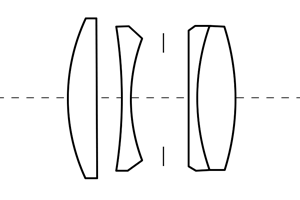
Typical specifications: 50 mm f/3.5; 50 mm f/2.8; 80 mm f/3.5; 85 mm f/3.5; 135mm f/3.5; 180mm f/3.5
Construction: 4 elements, 3 groups (Tessar design)
Available mounts: Exakta, Exakta 6×6, M42, Pentacon Six, Praktina
Origin of name: Unclear
Other specifications: The longer focal length variants were originally designed as medium and large format lenses, but were also made available as tele lenses in the prevalent 135-format mounts of the era.
History and trivia:
• Primotar is the name used by Meyer-Optik for their postwar Tessar-derived designs.
• While this would seem like a copycat move, many argue that the Primotar’s were not only fully competitive with Zeiss Jena’s Tessars, but were in some respects ahead of the competition.
Links:
• Primotar on Zeissikonveb.de
Trioplan (1930’s)
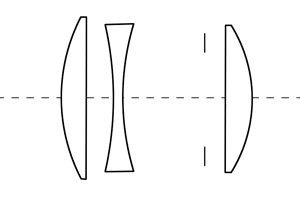
Typical specifications: 50 mm f/2.9; 100 mm f/2.8
Construction: 3 elements in 3 groups (Cooke Triplet)
Available mounts: Altix, Exakta, M42, Praktina, Primarflex
Origin of name: ‘Trio’ in the name refers to the three-element construction.
Other specifications:
• For 135 format: There were early variants with 105 mm f/2.8 and 120 mm f/4.5 but they seem to have been very rare.
• For larger formats: Trioplan lenses have a long history of having been used as fixed lenses on medium format cameras – ranging from standard-like 75/2.9, 75/3.5 and 75/4.5 designs to 100/2.8 designs. Some (rare) Trioplan lenses (such as a 210/3.5) also exist for large format cameras.
• For smaller formats: MOG seems also to have manufactured the Trioplan in small batches for C-mount (motion picture) cameras.
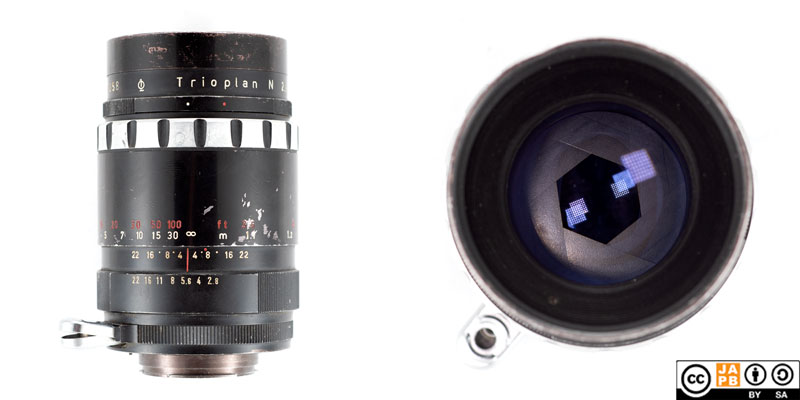
History and trivia:
• Originally offered as a lens for medium format camera, the 100 mm Trioplan was repurposed as a bright, medium tele lens for 135 format. The same design was then used for a semi-bright normal lens (50/2.9) that was also very common as a fixed-lens on entry-level cameras. After 1958 a new version (known as the Trioplan 100/2.8 N) was made for Exakta-mount using high-refractive index glass sorts, but with fewer aperture blades.
• While the Trioplan-line was originally discontinued in the 1960’s the same basic design was subsequently used for Diaplan projection lenses and the Domiplan budget standard lens.
• Recently (2015 onward) remake versions of the original 50/2.9 and 100/2.8 have been manufactured and sold by nMOG. These remakes use the original triplet design, but with modern glasses and coatings.
Links:
• JAPB Data Sheet on the MOG Trioplan-N 100 mm f/2.8
• Trioplan (100/2.8) group on Flick
• Trioplan on Zeissikonveb.de
Primoplan (1930’s)
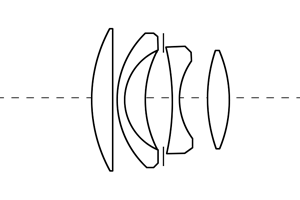
Typical specifications: 58mm f/1.9; 75mm f/1.9
Construction: 5 elements, 4 groups (Ernostar-derivative)
Available mounts: Exakta, M42
Origin of name: Unclear.
Other specifications:
• A 50/1.5 variant of the Primoplan was available for the Contax/Kiev mount.
• A 80/1.9 and an extremely rare 100 mm f/1.9 Primoplan seem to exist that cover medium format.
• Further, some Primoplan versions were made for 16 mm film (with correspondingly shorter focal lengths).
• There also exists a 50/1.9 prototype that is extremely rare.
History and trivia:
• The Primoplan 58/1.9 was introduced in 1936, and was – at that time – the largest-aperture standard lens for any SLR. Production was interrupted due to the war in 1942, and restarted in 1947. Later samples (marked with the red letter ‘V’) are coated, but earlier were uncoated.
• Designwise, the Primoplan is somewhat unique. Technically, the Primoplan is an extended triplet, with a doublet crammed in between the triplet’s first and second lenses. As such, it is different both from the Ernostar (also an extended Triplet) and the Sonnar that was a further development of the Ernostar.
• Production of the Primoplan was ended in 1959 (succeeded by the Domiron) – partially as the revolution in lens coatings made even faster double-gauss lenses feasible, partially as the Primoplan lacked any affordances for aperture automation
• The Primoplan is one of the designs offered today by nMOG.
Links:
• Primoplan on Zeissikonveb.de
• Primoplan 58 mm f/1.9 user reviews on pentaxforums.com
• Primoplan 58 mm f/1.9 on Flickr
Telemegor (1930’s)
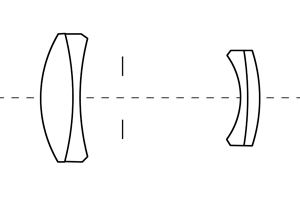
Typical specifications: 150 mm f/5.5; 180 mm f/5.5; 250mm f/5.5; 300mm f/4.5; 400 mm f/5.5
Construction:
• 4 elements, 2 groups (Classic Tele, all but 300/4.5)
• 4 elements in 3 groups 4 (300/4.5)
Available mounts: Exakta, M42, Pentacon Six, Praktina
Origin of name: ‘Telemegor’ is a compression of ‘Teleobjektiv Meyer Görlitz’ (Tele-Me-Gor)
Other specifications: none known.
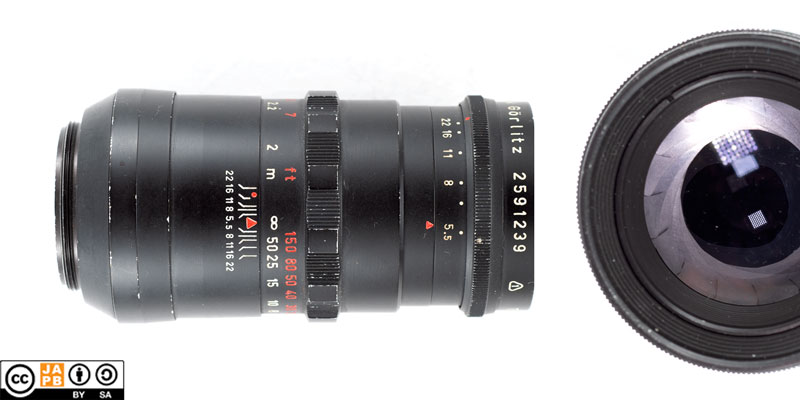
History and trivia:
• Classic Tele lenses are – as an invention – as old as the first mariners’ telescopes: The combination of a positive lens at the front and a negative lens at the eyepiece – separated by a significant distance.
• Problematically, such two-lens element tele lenses produced relatively poor imagery and were plagued especially by comatic aberration and chromatic aberrations. Willy Mertes, while working at Zeiss during World War I, managed to significantly improve the principle by replacing each lens element with a two-element group. As soon as the patent ran out in 1934, the competition introduced their own variants: In MOG’s case the Telemegor.
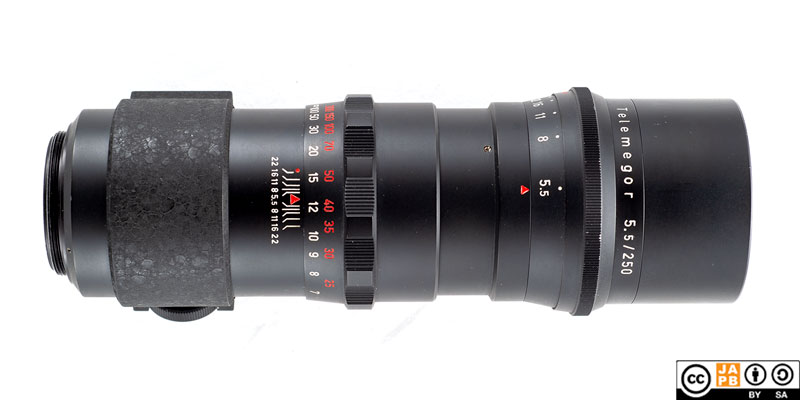
• The early Telemegors – characterized by a maximum aperture of f/5.5 and a range of focal lengths (from 150 mm to 400) – were relatively successful, but as the industry continued to develop, the early Telemegors started to look quite dated – both in terms of offering only a max aperture of f/5.5, but also in terms of image quality.
• The 300/4.5 Telemegor, introduced in 1955, was a minor but radical redesign. Through introducing an air lens in the previously cemented front doublet the maximum aperture could be increased and image quality improved. This lens remained in production until 1967 when it was replaced by the 300/4 Orestegor.
Links:
• JAPB Data Sheet on the MOG Telemegor 180 mm f/5.5
• JAPB Data Sheet on the MOG Telemegor 250 mm f/5.5
• Telemegor on Zeissikonveb.de
Helioplan (post-war)
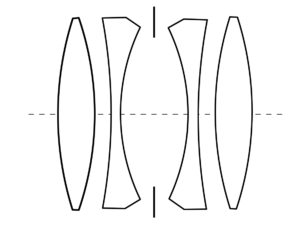
Typical specifications: 40 mm f/4.5
Construction: 4 elements, 4 groups
Available mounts: Exakta, M42
Origin of name: Uncertain. Alike many legacy lenses, its name includes allusions to the sun – In the case of the Helioplan this is not due to it being exceptionally bright.
Other specifications: The Helioplan was further offered as an enlarging lens as well as lens for various medium format and 4×5” fixed lens cameras.
History and trivia:
• The Helioplan was basically the direct descendant of an pre-war doppel-anastigmat and some fixed lenses can even be found named as Doppel-Anastigmat ‘Helioplan’. A lens being an Anastigmat or even Doppel Anastigmat was – once upon a time – a big selling point. In case you don’t know why, look here. Incidentally, almost all lenses today are Anastigmats – it just is no longer advertised.
• At 40 mm focal length this lens would today be classed as a standard lens, but in its day (way before retrofocus lenses (the today dominant approach to construct wide-angle lenses) were invented, 40 mm on an SLR was not at all shabby.
• The 4 elements in 4 groups is a classic Doppel-Anastigmat, made up of two anastigmatic lens groups in a an almost perfectly symmetrical arrangement. No wonder this lens had the characteristics for being used on enlargers.
Links:
• Helioplan on allphotolenses.com
• Helioplan on Flickr
Primagon (1950’s)
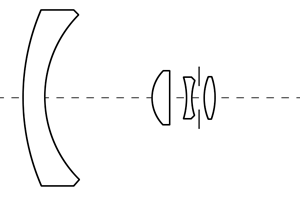
Typical specifications: 35 mm f/4.5
Construction: 4 elements, 4 groups
Available mounts: Altix, Exakta, M42, Praktina
Origin of name: Unclear, the naming clearly harkens to MOG’s ‘Prima’ -series and the ‘gon’-suffix is often used in German lenses to mean (wide) angle (e.g. Dista-gon/Bio-gon/Holo-gon/Flekto-gon)
Other specifications: none known.
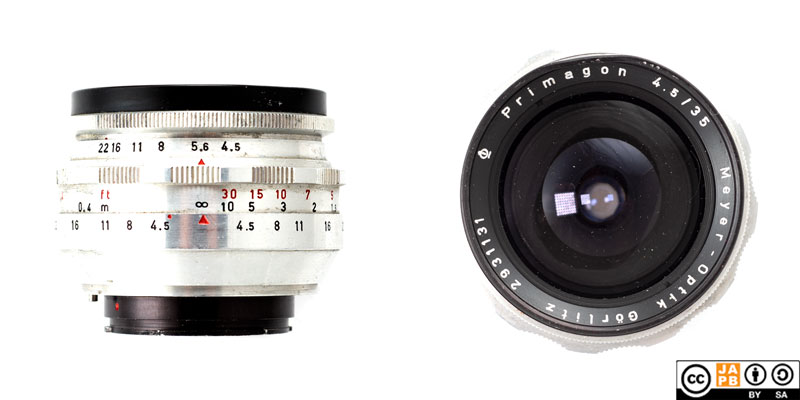
History and Trivia:
• Only 5 mm wider than the Helioplan, the Primagon was Meyer-Optik’s first stab at a retrofocus wide-angle lens, using a simple triplet, in combination with a negative element at the front.
• In production 1952–1964, until replaced with the Lydith.
• By all accounts, a rather well-liked lens.
Links:
• JAPB Data Sheet on the MOG Primagon 35 mm f/4.5
• Primagon on Zeissikonveb.de
• Primagon on Flickr
Telefogar (1950’s)
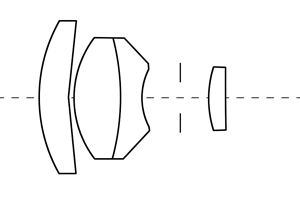
Typical specifications: 90 mm f/3.5
Construction: 4 elements in 3 groups (Sonnar-type)
Available mounts: Altix (Exakta, M42)
Origin of name: Uncertain, although the ‘Tele’ prefix was clearly intended to convey that the lens sported a relatively narrow field-of view.
Other specifications: Early brochures speak of a 90 mm f/4.5 version, but few have ever been seen.
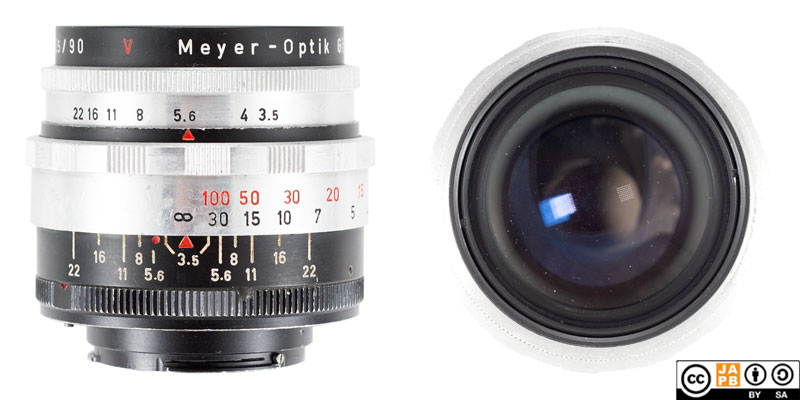
History and trivia:
• The Telefogar was originally developed for the Altix-range of cameras. The Altix was an interchangeable lens viewfinder with a leaf-shutter in the camera. Such an approach placed some very special limitations on lenses 5.
• As a result of those limitations, lenses originally designed for leaf shutter cameras cannot typically be mounted on SLR’s without significant redesign. Given that MOG already had a similar-spec, SLR-optimized tele lens in the Trioplan, a design variant of the Telefogar optimized for SLR’s was never made. Instead, those samples of the Telefogar for the Exakta or M42 mount, are most likely retrofitted by the factory or by independent craftsmen.
• Interestingly, those limitations that originally pained leaf shutter camera lenses on SLR’s no longer apply when aiming to use such lenses on mirrorless cameras.
• Due to its rather limiting provenance (Altix), the lens is far from commonplace.
• Even though its specifications are not especially attractive (not very bright (f/3.5), longish MFD (1,5 m)), the Telefogar is a very well-liked lens among those who have it.
Links:
• JAPB Data Sheet on MOG Telefogar 90 mm f/3.5
• JAPB Walk-around with the MOG Telefogar 90 mm f/3.5
• Telefogar on Zeissikonveb.de
• Telefogar on Flickr
Post-1960 designs
The 1960s were a big decade for Meyer-Optik Görlitz. Led by prominent lens designers such as Hubert Ulbrich, MOG revamped its entire lens lineup within one decade. In many ways, the 1960’s were a true golden age for Meyer-Optik, And the ignominious shotgun merger with camera maker Pentacon in 1970 to form the Pentacon combinate makes this golden age of MOG very bittersweet.
In all, the 60’s can be characterized as a play in two acts: The first act characterized by Domi-whatever named lenses, and the second and (sadly) final act characterized by Orest-something named lenses. And with a brief interlude in between.
Domiron (patented 1958)
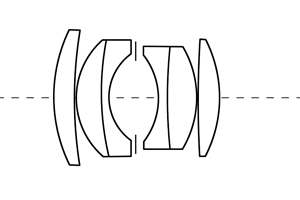
Typical specifications: 50 mm f/2
Construction: 6 elements in 4 groups (double-Gauss)
Available mounts: Exakta
Origin of name: Uncertain, part of the Domi-something family.
Patented: 1958; Marketed: 1960; Discontinued 1965
Other specifications: None.
History and trivia:
• While the 58/1.9 Primoplan had served MOG well at the time, it was long for a standard lens, and at f/1.9 it was at the outer limits of the advanced Ernostar design. Further, it could not easily be redesigned to offer aperture automation, which by the early 60’s had become par for the course.
• As simultaneously advancements in lens coatings allowed for increasing the number of air-glass interfaces, it was clear that the future of fast standard lenses lay in various double-Gauss derived designs. This is the origin of the 50/2 Domiron.
• While on paper a bit slower than the Primoplan it was designed to replace, it was in practice both faster (increased transmission) and significantly less prone to wide-open softness.
• While the Domiron turned out to be short-lived (quickly replaced by the even faster Oreston) it nevertheless served as a valuable testbed for MOG. Not only was the build quality very high, it offered MOG a chance to fine tune its approach to aperture automation and also offered MOG valuable experience in working with double-Gauss designs.
Links:
• Domiron on Allphotolenses.com
• Domiron on Zeissikonveb.de
Domigon (introduced 1960)
Domigon is the original name of the Lydith. While the lens was introduced as ‘Domigon’ the name change to Lydith seems to have happened very quickly as Domigon’s are very rarely seen (currently eBay does not even display a single sale).
Domigor (patented 1960)
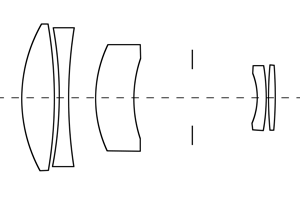
Typical specifications: 135 mm f/4
Construction: 5 elements in 5 groups
Available mounts: Pentina
Origin of name: Unclear, but part of the Domi-somethings
Other specifications: None known.
History and trivia:
• The Domigor is somewhat of an oddity here, as it was developed solely for the Pentina leaf shutter SLR camera (with all the issues that entails, see more in the section on the Telefogar).
• Sadly, neither the design-wise rather revolutionary Pentina nor the Domigor made any big impression, and the two minor reasons why it made it into this listing is a) it’s yet another ‘Domi’something; b) the five group design was very modern for its time.
Links:
Domigor mentioned on Zeissikonveb.de
Domiplan (introduced 1962)
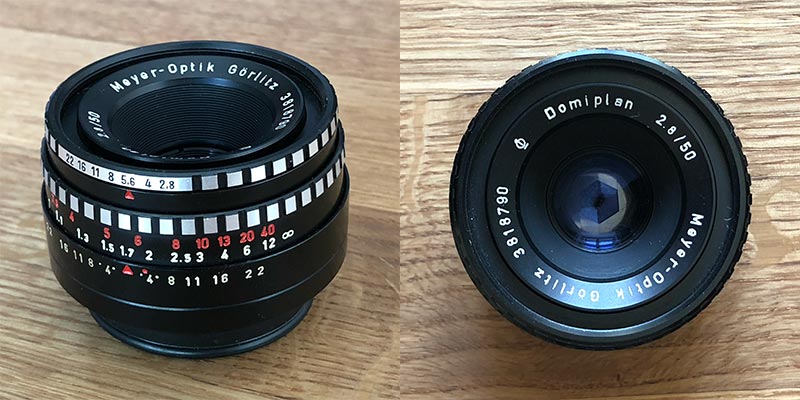
Typical specifications: 50 mm f/2.8
Construction: 3 elements in 3 groups (Cooke Triplet)
Available mounts: Exakta, M42
Origin of name: Unclear, but another Domi-something.
Other specifications: Some non-interchangable lens viewfinders were also produced using a lens branded ‘Domiplan’. Typically these ‘Domiplan’s would have specifications such as 30/3.5 or 45/2.8
History and trivia:
• The Domiplan took over where the 50/2.9 Trioplan left off.
• This lens was a simple triplet, offered as kit lens with most entry level Praktica and Exa SLR’s.
• The lens was introduced in 1962 and produced until 1979.
• The Domiplan was also offered for international markets as the ‘Pentaflex – Color’
• Because of their plentiful availability, this lens is the typically most affordable way into triplet lenses.
Links:
• JAPB data sheet on MOG Domiplan 50 mm f/2.8
• Mark Holtze’s (Youtube) review of the Domiplan
• Domiplan on allphotolenses.com
• Flickr’s Domiplan group
Lydith (re-introduced 1963)
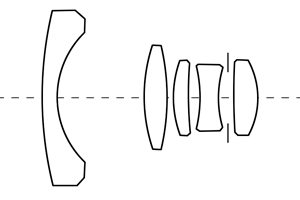
Typical specifications: 30 mm f/3.5
Construction: 5 elments in 5 groups
Available mounts: Altix, Exakta, M42, Pentina.
Origin of name: A mystery, as the name Lydith clearly deviates from both MOG’s 1960 naming logics (Domi-somethings and Orest-somethings)
Other specifications: none known
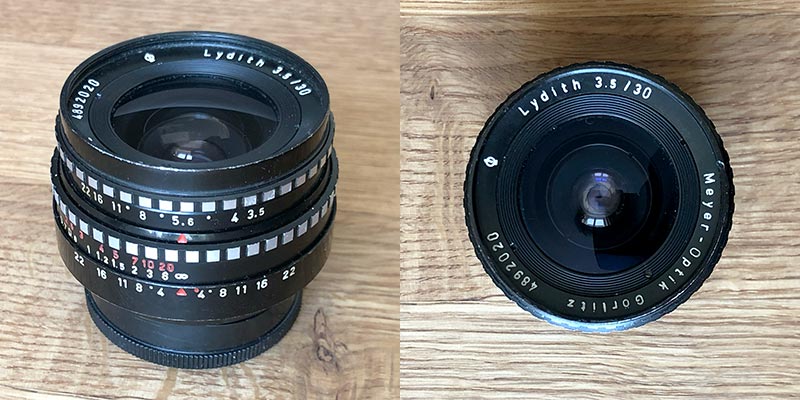
History and trivia:
• An iteration of the Primagon – a bit wider, a bit faster, and with one more lens element.
• Introduced originally in 1960 as the MOG Domigon for the Pentina leaf shutter SLR, but renamed shortly after introduction.
• As the Pentina did not take off, the Lydith was then re-introduced in 1963 in Exakta and M42 variants
• Later a minor series was even manufactured with an Altix mount.
• As a quirk, the Lydith was introduced using a preset aperture mechanism and remained as such until the end.
• In 1970 the lens was rebranded as Pentacon 30/3.5 (even then as a preset lens) and remained in production for three decades, making it the most venerable design in the line of MOG-Pentacon lenses.
• The Lydith is one of the designs offered today by nMOG.
Links:
• JAPB data sheet on MOG Lydith 30 mm f/3.5
• Flickr’s Lydith group
• Lydith on Zeissikonveb.de
Orestegor (introduced 1963–1968)
Typical specifications & Construction:
• 200 mm f/4 – 5 elements, 5 groups;
• 300 mm f/4 – 5 elements, 4 groups;
• 500 mm f/5.6 – 4 elements, 4 groups.
Available mounts: Exakta, M42, Pentacon Six, Praktina
Origin of name: Unclear, part of the Orest-something family. Possibly the gor-suffix harkens back to the Telemegor series it replaced.
Other specifications: There was also a factory adapter for the Altix.
Note: It had been customary at MOG, that one lens name could encompass a wide variety of lenses, but only with lenses that had the same design recipe. The name Orestegor differed from that rule in that the name enfolds three lenses that all have different recipies. MOG’s logic for using the common name seems to have been premised on that all three Orestegors were variants of a classic tele -approach (see more under the chapter on the Telemegor). However, as all three lenses followed quite different design trajectories, I will treat them here separately:
Orestegor 200 mm f/4 (1963)
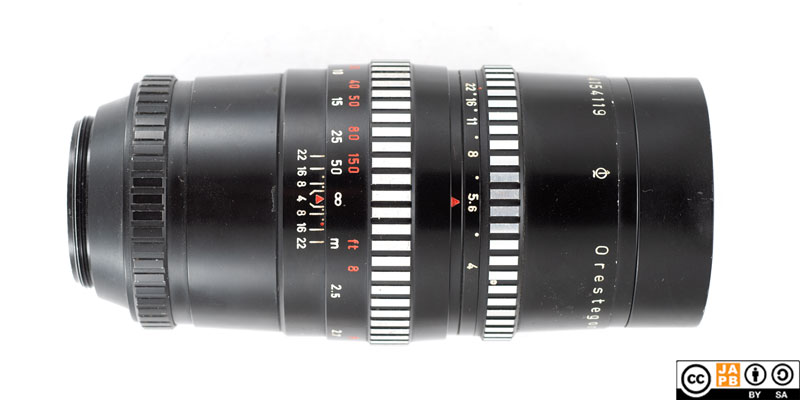
History and trivia:
• With the various versions of the venerable Telemegor family being decidedly long in the tooth and with MOG planning to overhaul its entire lens lineup, it was obvious that the real tele lenses were near the top of the priority list.
• As the 180 mm Telemegor had always been the most popular of MOG’s teles, a 200 mm tele was slated to be the top priority. As it further was seen as important to offer a significantly more bright lens (than the Telemegors’ rather dim f/5.5), the customary 4/4 design had to be extended to allow coma and chromatic aberrations to be kept in check. Thus the 5/5 200 mm Orestegor was born in 1961.
• Interestingly, chief designer Ulbrich decided to not cement the 2nd and 3rd elements together, instead they were simply machined to perfection and crammed so tightly together that many lens mechanics have found the lens elements to have stuck together through sheer pressure (the lenses have not fused, but the coatings have stuck together).
• The 200 mm Orestegor was inintially launched as a preset lens, and even after the lens was outwardly facelifted and given the Pentacon name, the 200/4 remained a preset lens (see data sheet).
• Later (in 1976) the lens was modernized to allow auto aperture (both mechanic and electronic approaches), and while the basic approach (5/5) remained unchanged, the glass types and element shapes did change a tad, making this (optically as well) a different design (see data sheet).
• The Pentacon 200 mm f/4 remained in production until the end of Meyer-Optik/Pentacon.
Links:
• JAPB data sheet on MOG Orestegor 200 mm f/4
• Orestegor 200 mm on Zeissikonveb.de
Orestegor 300 mm f/4 (1968)
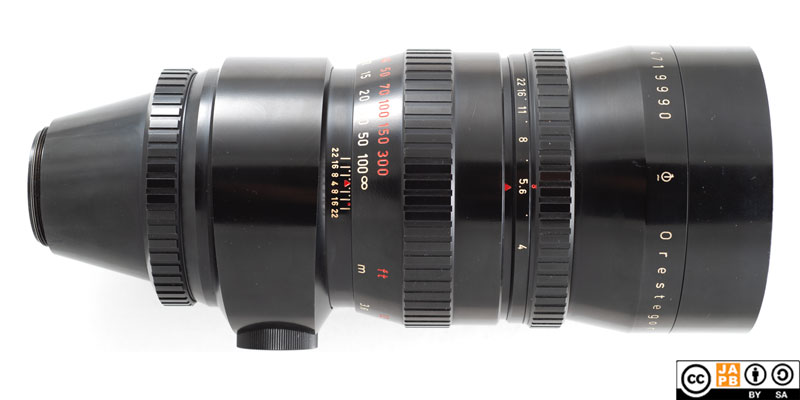
History and trivia:
• Using the successful 200 mm Orestegor as basis, Meyer-Optik developed a 300 mm f/4 lens that in many ways was Meyer-Optik’s crowning achievement.
• At a tad over two kilograms, the 300 mm Orestegor is a bit of a brick, but considering the image quality and brightness, this is by no means beyond the norm.
• After the Meyer-Optik–Pentacon merger, this lens remained in the lineup as the Pentacon 300 mm f/4.
• During the coming years this lens would be updated a number of times and was – all through to the end of the East German camera industry – the premium tele lens (challenged only by the 1980’s Carl Zeiss Jena 300/4).
Links:
• JAPB data sheet on MOG Orestegor 300 mm f/4
• 300 mm Orestegor on Zeissikonveb.de
Orestegor 500 mm f/5.6 (1963)
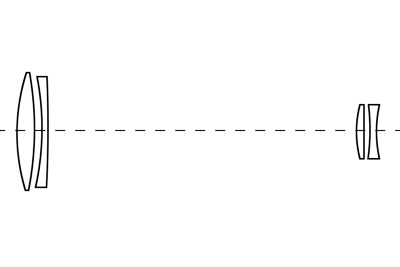
History and trivia:
• There has always been something sexy about superteles. On one hand, they’re de rigeur, for a system to be able to boast an impressive range of focal lengths, on the other hand, there are uses where superteles simply are a must-have (just ask a birder).
• The longest version of the venerable Telemegor had been a 400 mm variant, and while many had been happy with it, the lens clearly was not only outdated, but also in many respects far below what MOG was capable of. MOG simply had to offer something new to replace it.
• At the same time, there was the smallish but quality conscious crowd of Praktisix / Pentacon Six users to consider, to whom the 500 mm was more like normal tele.
• The 4 elements in 4 groups -design was an extension of the classic tele design, using air lenses to separate both groups, hence achieving improved correction.
• After MOG’s merger with Pentacon, the lens was briefly available under the name ‘Pentaconar’, before settling on Pentacon 500 mm f/5.6. A version of the 500 mm f/5.6 Pentaconar can be found on JAPB here.
Links:
• JAPB Data Sheet on the Pentaconar 500 mm f/5.6 (essentially the same lens)
• 500 mm Orestegor on Zeissikonveb.de
• Some comments on the Pentacon 500 mm f/5.6 on medium format
Oreston (introduced 1965)
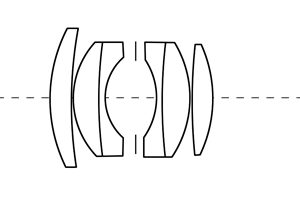
Typical specifications: 50 mm f/1.8
Construction: 6 elements in 4 groups (double-Gauss)
Available mounts: Exakta, M42
Origin of name: Unclear. Part of the Orest-something family.
Other specifications: None
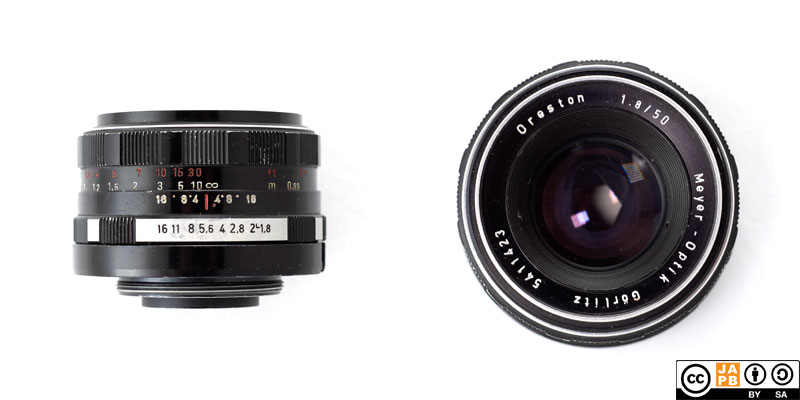
History and trivia:
• Originally introduced in 1965, The Oreston was a further development on the earlier Domiron. From the beginning, the purpose was to design a bright, affordable, standard lens.
• While the basic recipe (6 elements, 4 groups; double-Gauss) remained the same, the lens shapes were tweaked to allow for a maximum aperture of f/1.8, making the Oreston fully equivalent with the competition.
• In some respects it even outperformed the more prestigious Carl Zeiss Jena 50/1.8 Pancolar.
• Users were especially appreciative of the Oreston’s comparatively short MFD of 0,33 meters, facilitating its use as a close-up lens.
• The optical design was tweaked at the same time as the Oreston was renamed the Pentacon auto 50/1.8. Thereafter the optical recipe remained essentially the same until the end of production.
• Some version of the Oreston/Pentacon auto 50/1.8 was offered as the kit lens with countless entry- and mid-level Praktica cameras over the next two decades, making it one of the most common lenses ever produced. Due to a high supply, the lens remains very cheap and therefore offers tremendous bang/buck.
Links:
• JAPB data sheet on MOG Oreston 50 mm f/1.8
Orestor (introduced 1966)
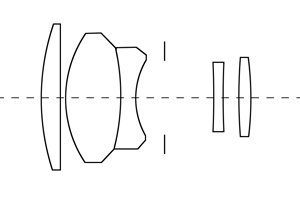
Typical specifications: 100 mm f/2.8 and 135 mm f/2.8
Construction: 5 elements in 4 groups (Sonnar -type)
Available mounts: Altix, Exakta, M42, Praktina
Origin of name: Part of the Orest-somethings.
Other specifications: none known
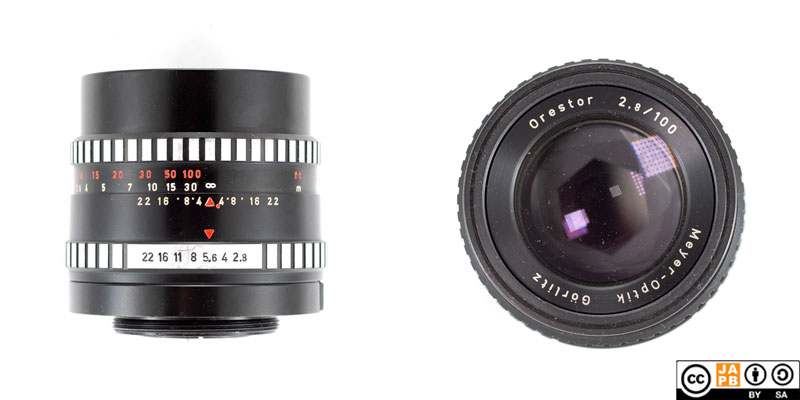
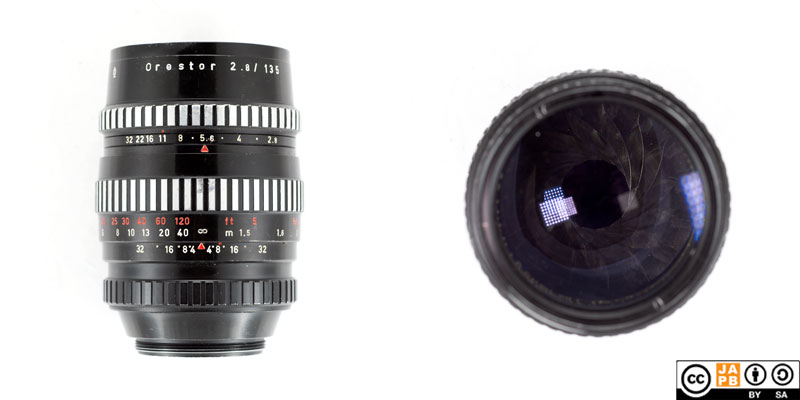
History and trivia:
• As part of the overhaul of MOG’s lens lineup, one obvious task was to produce a pair of short-to-medium tele lenses to fill the gap between the Oreston (50 mm) and Orestegor (200 mm).
• Both 100 and 135 mm variants used the same design, and offered the same maximum aperture.
• By specifications, the 100 mm Orestor has the same basic specs as the venerable Trioplan 100 mm f/2.8 (which it was intended to replace). And while the 100 mm Oreston lacks the Trioplan’s soap-bubble bokeh (which back then was not considered a plus), it has significantly higher definition and contrast, especially wide open.
• Early variants of both 100 and 135 mm Orestors are characterized by preset aperture mechanisms and high blade-counts, often referred to as bokeh–monsters.
• There were plans for a longer Orestor – a 200 mm f/2.8 – but it never made it into mass production.
• Although well-received, the 100 Orestor was dropped from the Pentacon lens lineup relatively early, leaving a considerable gap (between 50–135 mm) in the Pentacon lineup.
• Later variants (auto/electric) have fewer aperture blades but better coatings.
• The 135 mm Orestor was carried onwards in the MOG/Pentacon lineup until the end of the East German camera industry and beyond.
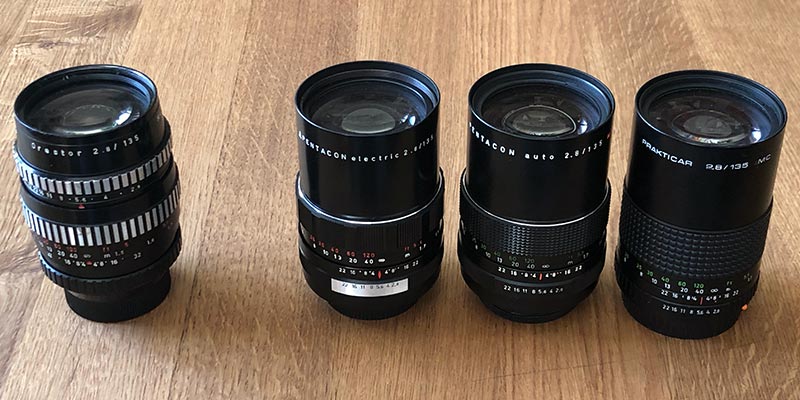
Left-to-Right:
• MOG Orestor 135 mm f/2.8 (M42, preset)
• Pentacon electric 135 mm f/2.8 (M42, auto + electric)
• Pentacon auto 134 mm f/2.8 MC (M42, auto)
• Pentacon Prakticar 135 mm f/2.8 (Praktica Bayonet)
(Missing in picture:
• Early (non-MC) M42 auto version
• Meyer-Optik 135 mm f/2.8 (Praktica Bayonet)
Links:
• JAPB data sheet on MOG Orestor 100 mm f/2.8
• JAPB data sheet on MOG Orestor 135 mm f/2.8
• Orestor on Zeissikonveb.de
• User reviews of 135 mm Orestor on Pentaxforums.com
• Orestor 135 mm group on Flickr
• Orestor 100 mm group on Flickr
Orestegon (introduced 1966)
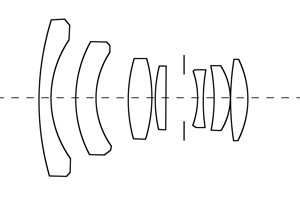
Typical specifications: 29 mm f/2.8
Construction: 7 elements in 7 groups
Available mounts: M42
Origin of name: Another “Orest”-lens, this time with the wide-angle-typical “gon” suffix
Other specifications: none known.

History and trivia:
• While well-liked, the Lydith did not offer particularly spectacular specifications. At 30 mm it was not really that wide, and at f/3.5 it was relatively dim. Moreover, the Lydith still did not support aperture automation.
• An upgrade was clearly called for. At 29 mm the Orestegon was not technically fully on par with the 28 mm lenses the competition was offering.
• The Orestegon was the widest lens manufactured by MOG.
• Interestingly, the initial pricing of the Orestegon indicates that MOG never aimed for it to be a premium lens. No surprise then, that both the Orestegon and Lydith remained in the Meyer-Optik / Pentacon lineup.
• It is noteworthy, that while the Pentacon 29 mm f/2.8 is a rebranded Orestegon, the later Pentacon Prakticar 28 mm f/2.8 is a fundamentally redesigned lens, and is reputed to perform a lot better.
Links:
• JAPB Data Sheet on MOG Orestegon 29 mm f/2.8
• Orestegon on Zeissikonveb.de
• Review of Orestegon
• Original brochure (in german)
Epilogue
After the MOG-Pentcaon merger, the new Pentacon combinate was set to take over the world (or at least its budget-conscious segment). And for some years that plan seemed to work well. The new line of Praktica cameras was offering tremendous bang/buck and the Pentacon (ex-MOG) lenses did deliver. Throughout the 70s and into the 80s, Praktica cameras and Pentacon lenses held respectable market shares in many western countries.
But one has to wonder whether Pentacon directors rested too comfortably on their laurels, or whether the focus on lens design was lost in the camera-focused Pentacon combinate, because even though many of the MOG designs were tweaked and redesigned for better industrial economics, there were – during the entire 70’s and 80’s – very few new designs.
In fact, notwithstanding the above mentioned Pentacon Prakticar 28 mm f/2.8 and the Pentacon Prakticar 50 mm f/2.4 Pancake – both offered only on the Praktica B-mount – there were no new Pentacon lenses after 1970. Instead, Pentacon’s phlegmatism towards lens development ran so deep that they started rebranding Japanese and Korean lenses – especially zooms – as “Pentacon” lenses.
To me, that feels like a very ignominious end to a proud legacy. But I guess that that’s a bourgeois concept.
Footnotes
- The name “Meyer-Optik” made a brief, hapless and relatively insignificant comeback in 1990-91. ↩︎
- The new Meyer-Optik Görlitz (link) is not directly related to the original optics company, even though nMOG has reintroduced some of the old company’s more legendary lens designs. ↩︎
- See especially zeissikonveb.de, which has done an amazing job at documenting the East-German camera and optics industry (mostly in German). ↩︎
- The 300/4.5 Telemegor is often misreported as having 4 elements in 2 groups. In reality, the front ‘group’ is air-spaced. ↩︎
- Specifically: To facilitate fast shutter speeds, the leaf shutter’s maximum opening was relatively small compared to the size of the actual mount. This meant that a) the hindmost lens element was typically placed very close to the leaf shutter and was as a result relatively small; b) to avoid unnecessary vignetting, placement of the lens’ aperture was a tricky business. These limitations, while relatively easy to deal with in normal-to-wide lenses, were especially troublesome for tele lenses. ↩︎
I have a Primotor E1:3.5/50 Myer-Optik Gorlitz 1785598 lens -can you tell me anything about this one -can’t find one with this number on Google. duckmariejo@live.com
Hi,
The Primotar E 50 mm f/3.5 lens is a post-WWII Tessar-type lens manufactured by Meyer-Optik Görlitz. The lens was offered at least in m42 and Exakta mounts.
The Primotar E is a bit of a specialty lens in that it actually is brighter than f/3.5 (which helped the photographer in composing and focusing), but was always stopped down to f/3.5 for shooting. Somewhat unusually, its sharpness was also optimised for f/3.5.
Some consider the Primotar E to be the best implementation of the basic Tessar design.
There was also a Primotar E 80 mm f/3.5 for medium format (Pentacon Six mount).
Basic specs (in English): https://lens-db.com/meyer-optik-gorlitz-primotar-e-50mm-f35-v-1956/
A lot of details (in German): https://zeissikonveb.de/start/objektive/normalobjektive/primotar.html
What a brilliant resource. Thanks for taking the time to assemble this, especially the lens diagrams.